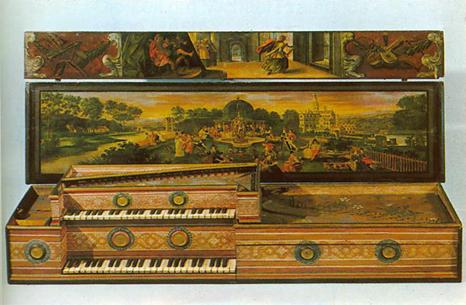Virginal

Double Virginal: „Mother and Child“, by Martinus van der Biest,
Antwerp 1580; Nuremberg, Germanisches Nationalmuseum
A specialty of Flemish virginal builders was the double virginal. A four-foot virginal was inserted into a kind of drawer of an eight-foot virginal so that the two instruments could be played side by side by two people. However, the smaller virginal could also be removed and, as seen here, placed over the keyboard.
Music example:
An excerpt from Jan Pieterszoon Sweelinck: More Palatino
played by Gustav Leonhardt.
Instrument: Double virginal: „Mother and Child“, by Martinus van der Biest, Antwerp 1580; Germanisches Nationalmuseum Nuremberg.
The center of harpsichord building in Flanders since the 16th century was Antwerp, home to the Ruckers family (later Couchet), who were active there from 1579. In the 18th century, the Dulcken family achieved comparable fame. A characteristic feature of Flemish harpsichord construction was the variety of types: in addition to wing-shaped instruments in different lengths (and therefore at different pitches) with up to three ranks, virginals were produced with either centrally or asymmetrically placed keyboards, either to the left (confusingly called spinet by later generations) or to the right (called muselaar) of the center. As the positions of the jacks on the strings changed accordingly (in the muselaar, for example, almost in the middle of the string, in the “spinet” near the bridge), these types sounded very different from each other.
Another peculiarity was the ‘mother and child’ virginals, essentially double instruments that could be played side by side in a single case. However, the smaller ‘child,’ tuned an octave higher than the ‘mother,’ could also be placed on top of the larger instrument, allowing for play on two manuals.
The instruments were often made externally from light linden wood, which required relatively thick walls. This allowed them to dispense with outer cases (as used in Italy), but the instruments were generally quite heavy to withstand the greater string tension. The large mass somewhat reduced the speed of response but provided significantly better resonance of tone, considered an ideal for sound development. Aside from Italy, Flemish harpsichord making influenced other countries too, as Flemish builders did not only produce for the domestic market; their instruments were widely exported, especially to France and England, but also to other countries. One of the oldest instruments by Hans Ruckers from 1581, for instance, has been preserved in Peru.
Flemish harpsichords were maintained, repaired, modified, and copied over centuries—in France, for example, there were specialists dedicated to adapting Flemish harpsichords to meet the modern requirements of the era. In England, craftsmen were apparently very skilled in copying—a famous harpsichord built in England (at Ham House) outwardly appears to be a Ruckers harpsichord from around 1630, but it was actually a deceptively similar copy made after 1700.
Towards the end of the 16th century, the Ruckers style also included designing keyboard instruments as expressly decorative pieces of furniture. The Flemish harpsichords and virginals of the Ruckers family and others were not only a treat for the ears but also for the eyes. Hardly any visible surface or recognizable structural detail was left without visual embellishment (harpsichord makers were not coincidentally part of the same guild as painters, the St. Luke's Guild in Antwerp). Hence, the interiors depicted by Flemish-Dutch painters of the 17th century, especially Vermeer, give the impression that having a virginal was essential in every household at the time.



